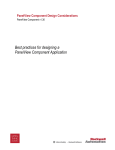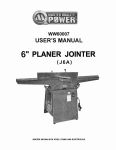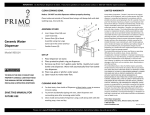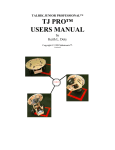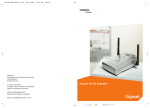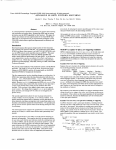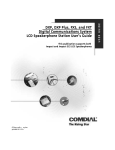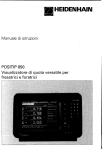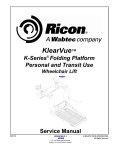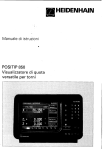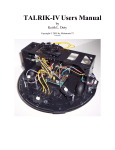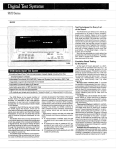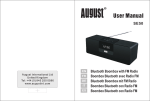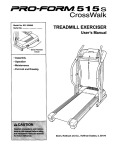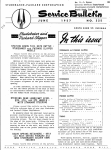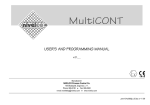Download InSyder User`s Manual
Transcript
User's Manual Using Using lnSyder With DOS lnSyder With CP/M 3.3 Clrtech CP/M Plus Is automatically fully compatible with lnSyder as a storage dev Ice. You can start up from a "System Master•, and use EXACTLY the same commands as with 5.25-lnch drives (for detal Is see your CP/M Plus manual). However, you SHOULD make a •system Part It Ion• for CP/M Plus (see Chapter 5 for detal Is), to leave space for other operating systems on your lnSyder drive. DOS 3.3 can usual IY use only 5.25-lnch disk dr Ives for storing fl les, so It must be modified to work with lnSyder. Before starting to use lnSyder with DOS 3.3 you should make one or more "System Partitions•, and associated "Partition Startup Programs• (see Chapter 5 for detal Is), for DOS. Each part It Ion should be 896K In size (as DOS can only use a maximum of SOOK on a volume), and on NO MORE than two volumes (If aval lable). Using several partitions al lows you to put more DOS programs onto lnSyder. Microsoft CP/M Is only compatible with 5.25-lnch drives UNLESS you use the CP/M support software on your /nSyder Support Disk to modify Microsoft CP/M for use with lnSyder, see below. To modify DOS 3.3 for lnSyder, Just fol low the procedure below: 1) Start up (activate) your DOS 3.3 partition (see Chapter 5 for detal Is). When the message "CANNOT STARTUP" appears, put a DOS 3.3 startup disk Into slot 6, drive 1, and press key "6". 2) When DOS 3.3 has started up (the cursor appears bes I de the "l" prompt>. rep I ace your DOS startup d I sk w Ith your I nSyder Support Disk, then type "BRUN LIDOS.LANG" and press Return. 3) When you see the "]" prompt again type "INIT HELLO,Sx" (replace "x" with the lnSyder slot number) then press Return. lnSyder Ordinary Microsoft CP/M can only use 5.25-lnch drives for storing flies, so It must be modified for lnSyder. Before starting you should make one or more "System Partitions" and "Partition Startup Programs• for CP/M (see Chapter 5 for deta I Is). Each partition can be up to 1536K (the maximum size per volume) and on NO MORE than two volumes (If aval lab le). Using several partitions wl I I let you use more of lnSyder for CP/M. You must now use "INSYDER.COM", from your lnSyder Support Disk, to modify CP/M. First start up your CP/M partition then (after "CANNOT STARTUP" appears) put your CP/M startup disk Into slot 6, drive 1, and press "6". CP/M will now start up. When the "A>" prompt appears replace this disk with your lnSyder Support Disk, type "INSYDER", then press Return (this will modify CP/M In memory). Now run "INFORM.COM" to format your CP/M partition for use. lnSyder wl I I now appear as one or two drives (If you made a partition on two volumes) to CP/M and CP/M programs. Your partition Is now formatted as a DOS startup disk, and you should repeat this for any other lnSyder DOS partitions. You can now start up DOS Instantly from your lnSyder partition, which wl I I appear as two 400K DOS drives (Dl and D2). If you have two volumes on lnSyder, and created the part It Ion on both volumes, then the second volume wl I I be D3 and D4 to DOS. To copy DOS f Iles to or from an lnSyder part It Ion, you must use the "UNIFID" program supplled on the lnSyder Support Disk (the normal FID program wl 11 not operate correctly with 400K drives). • This version of DOS has another Important feature; It al lows you to use ANY ProDOS compatible storage device with DOS (Including 3.5-lnch drives, RAM disks, etc). All drives appear as two 400K DOS disks for each "physical" drive. Use the DOS "INIT" command to make DOS startup disks on any drive. • (60K.): CPI/I 2.208 (56K.): After running INSYDER.COll the first lnSyder volume can be accessed as drive "E:" ca second volume wl 11 be drive "F:"). Starting Up CP!M As Microsoft CP/M cannot startup directly from lnSyder, you must startup from your CP/!A System disk, then run "INSYDER.COM". You must ALWAYS startup your CP/M part It ton, then type "6" to boot CP/M from disk, or you wl 11 not be able to access your CP/M data or programs on lnSyder). Al I standard CP/M commands work In EXACTLY the same way with lnSyder as with an ordinary disk. You can use "PIP.COM" Coran equivalent) to transfer CP/M programs and data to lnSyder. Using DOS 3.3 With The lnSyder Printer Adaptor The lnSyder SCSI Printer Adaptor lets you use lnSyder as a printer Interface. With the SCSI Printer Adaptor you may have to set your pr Inter for "LF after CR", and to "Ignore eighth bit" (control code interpretation Is NOT provided by fnSyder). CPIM 2.23 After running INSYDER.COll the first lnSyder volume can be accessed as drive "C:" (a second volume wll I be dr Ive "D:"). The version of DOS on lnSyder operates In EXACTLY the same way as ord I nary DOS (and us Ing your 5.25-1 nch dr Ives Is st 111 exact I y the same). All commands and operations are Identical (for full Instruct Ions refer to your Apple II DOS 3.3 Manual). ProDOS devices And Microsoft CP/M Versions 2.23 & 2.20b Leaving CP/M The "BOOT.COM" program (suppl led on your lnSyder Support Disk) Wiii let you re-start (or boot) your computer from any slot. Just type "BOOT s• Cs Is the start up slot) then press Return. Just use "PRtts" (s Is the lnSyder slot) to turn on the card from AppleSoft BASIC. Programs that use the standard BASIC entry point wl I I work perfectly with the SCSI Printer Adaptor. 4-7 4-8 Using lnSyder With Pascal t.3 Apple 11 Pascal 1.3wl11 automat I cal ly recognise lnSyder (when Installed In slot 4, 5 or 6), and wl II support the first two volumes provided by lnSyder. Before you start to use Pascal, you should make one or more •system Partitions• and "Partition Startup Programs• for Pascal (see Chapter 5 for detal Is). Pascal can only use up to 16Mb per volume (and two volumes maximum). Pl acing Pascal Into more than one partition allows you to use more space on your lnSyder drive for Pascal. First start up your Pascal partition (see Chapter 5), then, when the "CANNOT STARTUP" message appears, place your APPLE1: disk Into slot 6, drive 1, and press "6". Pascal wl 11 now start up as usual. Use the Pascal Formatter to format your lnSyder volumes, then copy the Pascal System Fl les, using F)I ler, from your Pascal disks to the first lnSyder volume. Next time you start up your Pascal partition, Pascal wlll start up dlrectly from It. CHAPTER 5 lnSyder PARTITIONS Two types of partitioning can be used with lnSyder. The first Is the Automatic Partition System, used by GS/OS and ProDOS 8, which partitions lnSyder drives larger than 32Mb (the maximum size usab Ie by GS/OS and ProDOS 8). Secondly, the versat I le System Partitions wl 11 let you use your first two lnSyder drives with several operating systems, and also (If one or both are EXTERNAL), share them other computers. Al I Pascal commands and functions operate In EXACTLY the same way with lnsyder as with ordinary disk devices. Automatic Partitions How To Start Up From lnSyder You can start up from lnSyder If you make It Into a startup disk (If you do not have an Integral drive you can only start up from an external SCSI device which Is set to SCSI ID number 0). With GS/OS, ProDOS, Clrtech CP/M Plus, or Pascal 1.3 you can make lnSyder Into a startup disk In EXACTLY the same way as an ordinary disk. For full detal Is of startup disks (sometimes referred to as "boot" disks) you must refer to the Instruction manuals suppl led with your operating system. For example, a 40Mb Integral drive wl II automatlcal ly be divided Into two volumes, which are accessed as a 32Mb drive 1 and an SMb drive 2 (the remainder of the drive); a 100Mb SCSI drive will be divided Into three 32Mb volumes and a 4Mb volume. • wI th GS/OS (When the "I NSYDER" dr Iver Is Insta I Ied) th Is system wl 11 operate with any and al I lnSyder dr Ives. If you are using ProDOS 8, due to Its I Imitations In disk and slot handl Ing, only the first two lnSyder drives can be automatlcal ly partitioned. DOS 3.3 WI th DOS 3.3 the INIT command w 111 automat Ical I y make your lnSyder DOS partltlton Into a startup disk (refer to your Apple DOS 3.3 Manual for full Instructions). • II I crosoft CPI II With Microsoft CP/M you CANNOT start up from your lnSyder partition (because this CP/M was designed to work only with 5.25-lnch disk drives), so you must always start up from your ordinary Microsoft CP/M System Master disk (AFTER starting up your partition), then run the INSYDER.COll program. With the Apple llGS you can use the bul It-In Control Panel Program to make the lnSyder slot (or any slot) the start up slot. 4-8 The bul It-In Automatic Partition System makes any lnSyder drive larger than 32Mb appear as multiple 32Mb volumes and a remainder volume Cother SCSI cards, unllke lnSyder, need speclal software to do this). This feature automat I cal ly al lows ful I use of a large lnSyder drive with GS/OS and ProDOS 8. System Partitions A System Partition Is a special reserved area that you can create on an lnSyder drive. Up to 63 partitions can be created on each of the first two drives and, If several volumes are aval lable, you can make a partition appear In al I or some of the volumes. Any partition on an lnSyder drive Is completely separate from any other partition or area on that drive. With the Apple //e you can restart your computer from lnSyder If it is In a higher slot than any other disk device. Figure 5-1 shows an 80Mb lnSyder drive which contains several System Partitions Cof course, before these partitions were created the drive was divided Into three volumes by the built-In Automatic Partition System). To start up from lnSyder (when using BASIC) type "PRu", where s Is the lnSyder slot number, HOLD DOWN the Option and Apple keys Cor both Apple keys on the Apple //e), then press the Return key. The three partitions on this drive are described below. 5-1 • Partition Nu•ber 1 This partition has three equal-sized parts, one In each volume provided for the lnSyder drive. In this example a 4Mb partition has been created on three volumes, which reserves a total of 12Mb (see "How To Create Partitions• for full Instructions). From figure 5-1 you wlll see that, for any partition created on more than one volume, the parts In each volume are always the same size. • Partition Number 2 This 10Mb partition Is the simplest one on the drive, as It has been created on only the f lrst volume. The space reserved Is slmply 10Mb. • Partition Number 1 - a 4Mb partition on all three volumes C12Mb) Partition Number 2 - a 10Mb partition on volume 1 only C10Mb) Partition Number 3 - a 5Mb partition on volume 1 and 2 C10Mb) 80 Mbyte lnSyder Drive-----. 32 Mbyte Volume 2 16 Mbyte Volume 3 F'roDOS Cat ProDo·; cat F'roDOS Cet Pro Do·:; file5 etc. ProDOS files etc.. ProDOS files etc .. 32 Mbyte Volume I Boot_ Block~' Partition Number 3 This partition has two equal-sized parts, one In each of the first two volumes provided by lnSyder. As a 5Mb partition has been created on two volumes, a total of 10Mb Is reserved. There are two reasons for using System Partitions to al locate space on an InSyder dr Ive: for d I fferent Cnon-ProDOS) operat Ing systems, and for different users In a multi-user system. A partition Is started up Cor activated) using a Partition Startup Program, which Is a small ProDOS "SYSTEM" program that starts up specific partitions on either or both lnSyder drives. With ProDOS 8, when a partition Is active It replaces the volume In which It was created. The partition appears as a drive volume, and behaves Just llke any other normal drive, with all other parts of thephyslcal drive being lnaccesslblewhllethe partition Is being used. For example, starting up Partition Number 3 Cln figure 5-1) makes the rest of the drive "lnvlslble"; untl I you leave the partition ONLY drive 1 (the Volume 1 part of the partition) and drive 2 (the Volume 2 part) are available. Pro DOS files etc .. Pro DOS files etc.. A partition on the first Drive and a partition on the second Drive (If one Is connected) can be llnked together using a Partition Startup Program; starting up the drive 1 partition wl I I automatically make the I Inked drive 2 partition accessible. For full details see, "How To Create A Partition Startup Program". WI th GS/OS you can access a ProDOS part It Ion wITHO UT hav Ing to start It up, as It wl 11 appear as a drive on the Finder Desktop, but for a partition which contains a non-ProDOS operating system you must stl II start up the partition before It can be used (and the rest of the drive becomes "lnvlslble", as for ProDOS 8). .................................................................................................................................. Running Programs To run a GS program In a partition on the Finder Desktop, use the mouse to "doub Ie-c I I ck" on the program I con. You can a I so run ProDOS 8 programs in this way, but ONLY If they are In an active partition on the first two lnSyder drives, or In another drive. ProDOS files etc Figure 5-1: ProDOS files etc .. lnSyder Syste• Partitions. ·································································································································· You can remove and create partitions at any time. When any partition Is removed the space that It reserved will be restored to the main ProDOS area of the lnSyder drive. 5-2 Now read the following sections for full detalls on creating and using lnSyder partitions. 5-3 7) A "PARTITION.MAP" f I le Is now automat I cal ly created In the first volume In which your partition exists. This flle contains all the details for ALL partitions on this drive. lnSyder Partition Creation And Maintenance The first and second drives connected to lnSyder (for example, Integral drive and SCSI drive, or two SCSI drives) can each have up to 63 partitions created within them. WARNING If tnSyder provides more than one volume for a drive, you can create partitions which exist on several or all of the volumes. Each tnSyder partition works I Ike a completely separate drive, and It can be used ONLY by the operating system you put Into It. How To Create Partitions To create a partition Just follow the Instructions below (but note that any drive must already be formatted for use by ProDOS before you can create partitions on It). 1) Start up from your lnSyder Support Disk. 2) Press •1• for "Partition Creation & Maintenance"; you wlll see a partition map (which Is empty) for drive 1, with a I 1st of commands along the top of your screen: (C)reate, (R)emove, (A)lter, Dev (1), (2), or (Q)ult? 3) Press ·c• to create a partition on the first drive. A "window• will now appear on your screen, showing the maximum size of partition that you can create. If only one volume ts provided you can go straight to step 4. If more than one volume Is avallable, you must now enter the number of volumes on which to create the partition. A partition can be created on al I lnSyder volumes, on 32Mb volumes only (which may make the most space avaltable) or on some 32Mb volumes Cfor example, some operating systems llmlt access to the first two lnSyder volumes, so It would waste space to create a partition on any more than two volumes). 4) Enter the "Partition size", mlnlnmum 128K (this will be rounded DOWN to the nearest 128K boundary). 5) Press "N" for the "Make Protected?" option. (this option ts only relevant within a multi-user system, see Chapter 6, "THE lnSyder MULTI-USER SYSTEM", for details. 6) .. ·;·;··;;;~··d;·;~·;·;··;·~;··;;·~,,:;·;1·;·(;;,:·;"A1;; ;;··;~·:";~;··~;;·;·;·t·;~;;~"(;~-;;·"A'i."i. data and programs In them/) on the drive wt 11 be LOST, and the partition space wilt NOT be restored to ProDOS; the drive would have to be re-formatted to recover the partition space/ Now your screen wt I I show the number of your part It Ion and I ts size, number of volumes, operat Ing system and "owner" (which ts the SCSI ID number of the computer that created the partition, again, only Important In a Multl-User System). You can create more part It Ions on dr Ive 1, and also on a second dr Ive; press "2" to select dr Ive 2, then (after the part It Ion map has been dlsplayed) follow step 1 to step 7 again. For use wIth ProDOS 8 Cassum Ing that you do not use GS/OS), and for any partition which Is to contain a non-ProDOS operating system, you should now create one or more Partition Startup Programs, so that you can activate your partltlon<sJ (for full detal Is, see "How To Create A Part It Ion Startup Program", below). 1f you use GS/OS w I th GS and ProDOS programs you w I I I not need Partition Startup Programs, as ProDOS partitions In the main ProDOS area of your tnSyder drives (and within active ProDOS partitions) wll I appear as drives on the GS Finder Desktop. After creating al I your partitions, you should make a back-up copy of the "PARTITION.MAP" flle on a drive. If deleted accldental ly, you can copy the back-up version to the drive to restore your partitions. You MUST make a NEW back-up copy of the "PARTITION.MAP" fl le If you add, remove or alter any partitions on the dr Ive. You MUST NOT move a "PART IT ION.MAP" Into a fo Ider or sub-directory, or rename It or lock It, otherwise your partitions WI I I not be access Ible (the PARTITION.MAP fl le MUST be In the main (root) ProDOS directory of a drive. How To Change The Size Of A Partition To change the size of a partition, remove It, then create a new partition of the size that you want. Remember that you must back up anything Important stored In your partition BEFORE you remove It, as removing a partition wlll DESTROY the contents. After you create your new partition you MUST make a NEW back-up copy of the "PARTITION.MAP" flle, and MUST NOT keep any old back-up copies! Press "O" - "4" for the appropr late "Operat Ing System". Th Is def Ines the operat Ing system type for use In the part 1t ion <none, ProDOS, DOS 3.3, etcJ, which you can change at any t lme using the (A)lter command (remember that GS/OS wI I I IGNORE any ncn-ProDOS part it Ion). 5-4 Press •y• to create your part It ton. Removing a Partition To remove a partition, start up from your lnSyder Support Disk, press •1• for "Part It Ion Creat Ion & Maintenance•, then press "R" to remove a partition. MAKE SURE that you copy any valuable data from the partition BEFORE you remove It. Removing a partition WI I I PERMANENTLY destroy all data contained In It! 5-5 How To Create A Partition Startup Program You must create Partition Startup Programs so that you can start up and use partitions which (with ProDOS 8 or GS/OS) are for different Cnon-ProDOS) operating systems, or (with ProDOS 8 only) are for a multl-user system. You can create as many Partition Startup Programs as you want, at any time, which you can copy to another ProDOS partition to let you •switch" directly from one partition to another. A Partition Startup Program (for ProDOS 8) can also "llnk" a partition on the first lnSyder drive to a partition on a second drive; the second partition wlll then automatically be activated Cand accessible) when you run the startup program. Partitions on each drive can be switched Independently, and you can even switch partitions on drive 2 WITHOUT restarting from drive 11 To create a Partition Startup Program (which Is a ProDOS 8 "SYSTEM" program), fol low the step-by-step Instructions below. 1) Startup from your lnSYder Support Disk. 2) Press "2" for "Make System Startup Program"; you wl 11 see a partition map (which Is empty) for drive 1, w.lth a llst of commands along the top of your screen: (C)reate, Dev (1), (2), or (Q)ult? At this point you can press •1• or •2• to change the llst of partitions displayed for drive 1 or drive 2 (although you can only select drive 2 If a second drive Is connected) . 3) Press "C" to create a Startup Program on your drive. A "window" wlll now appear on your screen, showing the options you have for creating Startup Programs. 4) Enter the number of the part It Ion that you want to start up on the first drive, use "X" If you do not want to startup or change a partition (so you can, for example, remain In a drive 1 partition but change the drive 2 partition). You can also enter "O" to DISABLE the drive, so that NO partition OR volume will be avallable (but If you disable drive 1 you wlll also be unable to activate any drive 2 partitions) . 5) Enter the number of the part It Ion that you want to start up on the second drive. You can also press "X" or "O" for this drive, see step 4 for details. 6) Type a name for the Partition Startup Program (this must not start with a number, can be up to 15 characters long, and must only contain letter, number, or "." characters . 7) Press "Y" to create the Partition Startup Program . Now you can run your Startup Program to activate the appropriate partitlon(sJ. However, when you try to start up a partition for the first time there wlll be no operating system, Just llke an ordinary blank disk, so you must now format your partition for 5-6 ....-.. ......... ........... .......... .......... ..... .... ........... ........ the appropriate operating system . When you try to start up, a "CANNOT STARTUP ... " message WI 11 be dlsplayed. You should then put a startup disk (for the operating system that you want to use In the partition) Into a disk drive, then type the slot number of that drive. DO NOT RESTART YOUR COMPUTER, Just Insert the startup disk for your operating system, then press the disk drive slot number . When your operat Ing system has started up you can format your partition (see "How to use lnSyder"), make It Into a startup disk (If It Is on drive 1), then use It In EXACTLY the same way as an ordinary disk dr Ive. IMPORTANT You can /eave a ProDOS 8 partition by running a Partition Startup Program, to switch to a different partition. You can /eave any partition by starting up from lnSYder, which returns you to the main (or "root") ProDOS area of the f lrst two lnSyder drives. If you launch a ProDOS 8 program from GS/OS you can Just "quit" back to GS/OS, which can access any "root" ProDOS partitions and a/so ProDOS partitions within a ProDOS partition (If not protected by another user In a •ultl-user system, see Chapter 6 for details). With ProDOS 8, If you want to make a backup copy of anything In a partition (whether ProDOS or non-ProDOS), you must first start up the partition before you can make a copy. With GS/OS you can copy anyt h Ing from a root ProDOS part It Ion, or any ProDOS partitions within a ProDOS partition (which also appear as drives on the Finder Desktop), but you must stlll start-up a non-ProDOS partition before you can copy anything In It. You can make as many Partition Startup Programs as you want, to start up partitions for different operating systems or, under ProDOS 8, for different users In a mul t I-user system. You can safely delete a Partition Startup Program without affecting the contents of a partition. ............. ............. .,,. ........... .... El 5-7 ..--... ..---... ........... ....... ...... .......... ....... .......... .... ...-.... ...-... CHAPTER 6 THE lnSyder MULTI-USER SYSTEM This chapter describes how to set up a multi-user system, which wl I I al low sharing of SCSI drives between up to seven computers . Integral drive If you have an Integral 20Mb or 40Mb drive you can share ONLY the first external SCSI drive connected to lnSyder. You CANNOT share the Integral drive with other users .................................................................................................................................. The Multi-User System uses System Partlt Ions (see Chapter 5) to al low safe sharing of SCSI drives. Up to seven computers can be connected to the same drive, using SCSI cables to "chain" one computer to the next Csee figure 6-1). This saves having an expensive hard disk for each computer, AND allows users to share common programs and data . Why You Need The Multi-User System You need the Multi-User System so that you can safely share an SCSI drive with several other people . In theory, you could Just connect several computers to the same SCSI hard disk. Unfortunately, current operating systems for Apple II computers do not support simultaneous access by several systems to the same flle or disk. The example below shows what can go wrong when two people try to use the same fl le . 1) Cathy loads the data base fl le called "NAMES" and starts adding new entries to It . 2) At the same time, Tom also loads "NAMES" and begins to add entries to It . 3) Cathy finishes adding entries and saves "NAMES" back to disk . 4) Finally, Tom also finishes using "NAMES" and saves It back onto the d Isk . As you can see, only the version of "NAMES" modified by Tom Is now on the disk; the version Cathy modlf led has been LOST! Even more seriously, If Cathy and Tom happened to save something to the disk at exactly the same time, the catalog on the disk could be DESTROYED and ALL files on the disk could be LOST. 8-1 How The Multl-User System Works 3) Attach the cable from your scs I dr Ive to the T-connector on the first computer In your system. 4) Attach the first computer In your system to the next computer (using an SCSI cable), then attach al I the remaining computers together Csee f lgure 6-1 ). The Mu/ti-User Syste• overcomes the problems described above by using "System Partitions• to reserve space for each computer connected to an lnSyder SCSI drive. T-Connector Each user creates their own System Part It Ions (see Chapter 5, "lnSyder PARTITIONS", for detal Is), and NO user can modify data or save to another user's partition. However, any user CAN activate a partition •owned" by another user and READ programs and flles from It (the •owner• of a partition can make the partition •protected", In which case other users wlll NOT be able to activate It OR read from It). D D • • This system lets several users SAFELY share an SCSI hard disk, and the flles stored In It, for such things as a database, word processing, Desk-Top-Pub I Ish Ing, and so on; for more detal Is see "An Example Mui ti-User System• at the end of this chapter. How To Set Up A Multl-User System IMPORTANT • One lnSyder (with or without Integral drive) for EACH computer In your multl-user system • One SCSI T-connector for each lnSyder • One SCSI cable for each lnSyder Figure 6-1: 5) be more than 6 metres, to comply with the SCSI standard. • One SCSI Terminator for the LAST computer In your system • One or two SCSI hard disk drives which use a block size of 512-bytes, and which comply with the ANSI X3T9.2 (Common Command Set) specification. IMPORTANT IMPORTANT 'j,'~~··~·~·~~··~~·;··"d·i""f"f~;·;~~··5;:-s·i···;·;··~~;·~;;~·:···;·;·~~···~···;·~····;·:···;·~;··;~~-h lnSyder In your system (see Chapter 8, "The lnSyder Links". for details). Also. your first SCSI drive MUST have ID 0, and a second drive have ID 1. .................................................................................................................................. 2) Attach a T-connector to the SCSI port on each lnSyder. Attach your SCSI Terminator to the T-connector on the LAST computer In your system. .................................................................................................................................. You must have SCSI bus terminators st BOTH ENDS of the chain of cables connecting your system, one terminator st your SCSI device (the correct type should be supplied with the device) and one connected to the empty T-connector socket on the LAST computer In your mu/ti-user system. 6) lnstal I each lnSyder for each computer In your system, see Chapter 3 for ful I lnstal lat Ion Instruct Ions. A Multi-User System. .................................................................................................................................. Just fol low the step-by-step Instructions below to connect your multi-user system together. 1) • • ·································································································································· The total length of SCSI cable In your Mu/ti-User System must not .................................................................................................................................. D D You must have the fol low Ing Items to set up a multl-user system: IMPORTANT Each user should now create a •personal" System Partition, to reserve the amount of storage space that they require on each drive, then they can make their own Partition Startup Program to activate their partitions (for details see Chapter 5, "lnSyder Partition Creation And Maintenance"). .................................................................................................................................. You MUST make ABSOLUTELY SURE that no other user Is a/so cresting their persona/ partition, or the Partition Startup Progra• for It, at the same time as you/ For details of the reasons why this would cause problems, see ·why You Need The Multi-User System·. .................................................................................................................................. Each user now has a Partition Startup Program, for their personal partition, In the main ProDOS section of the hard disk. Once each user has created their own personal partition on a drive 6-3 they can safely do anything whl le Inside It, such as creating other partitions within It (for other operating systems, using the same procedure as above> or using programs, see figure s-2. The main section of the hard disk must contain "PRODOS" (which Is the ProDOS 8 "SYS" f I I e) and a s I mp I e program I auncher (such as "ProSEL" or "BAS IC.SYSTEM") so that Part It Ion Startup Programs can be run. Each user first starts up from the main, or root, ProDOS area of the hard disk, then runs their Partition Startup Program to activate their personal partition. It Is MOST IMPORTANT that the main ProDOS area of the hard disk Is NOT used to store any fl les or programs; It must be used only for entering a particular personal partition (for full detalls of the reasons see "Why You Need The Multl-User System"). · GS/OS SCSI Drive .................................................................................................................................. If you want personal partitions to be activated as fast as possible, GS/OS should NOT start up from the main Prooos section of the hard disk (this Is because GS/OS takes much longer to start up than ProDOS 8; also, If you are going to use GS/OS In your partition, there Is no point starting It up twice!) . .................................................................................................................................. It Is possible to make starting up In a multi-user system completely automatic! For example, when you switch on your computer It can enter your personal partition directly, without hav Ing to "manua 11 y" run a Part It Ion Startup Program. For deta 11 s see "Automatic Partition Startup• at the end of this chapter. If two drives are connected to lnSyder, you can create Partition Startup Programs that switch partitions on the second drive WITHOUT affecting the first drive Csee Chapter 5 for details). This provides an easy method for copying data from another user's second drive partition Into your second drive partition. To do this you would run the Partition Startup Program that activates your drive 1 partition and the OTHER USER'S drive 2 partition. You would then copy the fl le you want from drive 2 (the other users partition) to drive 1 (your partition). The next step Is to run the Partition Startup Program that leaves the current drive 1 partition active (option "X" during the startup program creation> and activates YOUR drive 2 partition. You can then copy the flle from drive 1 to your drive 2 partition! ProDOS c Flies 0 E E 0 u ProDOS Files 1rt___1 ~ DOSBootlMdw DOS Programs and Data ~~ It Is always best to think out and plan what you want to be able to do first, then try It out (remember that you can easl ly remove partitions, or startup programs, If something does not work out properly); the examples on the fol low Ing pages may help to guide you, and we are sure that the versatl 1 lty of the partitioning system will provide a solution! Cf'IM Boot Loedw ProDOS Flies CP/Mdftctory CP/M ... ______ Flies .... Figure 6-2: Multi-User Partitions. 8-5 Automatic partition startup An Example Multi-User System In this example, a small shop contains a system of three computers. The first Is used to generate sales receipts, the second for account I nformat Ion and the th I rd to generate marketing Information. The sales receipt data Includes customers names and addresses, In addition to sales values. The accounts and marketing computers have an Integral drive f ltted to an lnSyder card and are connected to a single external SCSI hard disk using the Multi-User System. The sales computer has an lnSyder card without an Integral drive, and Is also connected to the SCSI hard disk. Each user has their own partition on the SCSI hard disk; partition •1 belongs to sales, •2 to accounts and •3 to marketing. The accounts and marketing computers partitions are marked as PROTECTED, to prevent any other user viewing their contents. All the computers use AppleWorks as their main program; sales uses the database to enter receipts, accounts uses the spreadsheet to prepare cash flows and marketing uses the word processor to prepare mal I lngs to customers. It Is clear that al 1 three computers need to extract Information from the database of sa Ies rece Ipts. The Mult I-user System al lows al I three computers to access the same database fl le. The setup required Is as fol lows: 1) The Integral drives f ltted to the accounts and marketing computers have no partitions <remember that the Integral drive cannot be "shared" by other users) and are used to keep sensitive Information that Is not "shared" with others. 2) Each user has a Partition Startup Program to let them access their own partitions on the external drive. The sales computer ONLY has a partition on the external SCSI drive, so It would have a startup program with "O" for drive 2 and "1" for drive 1; the other computers having "2" or "3" for drive 2 and "X" (for NO CHANGE) for dr Ive 1. 3) In addition, the accounts and marketing computers have a second Partition Startup Program with "1" for drive 2 and "X" for drive 1. This program activates the "SALES" partition on the external SCSI drive, without changing the drive 1 partition (there are no drive 1 partitions In any case). As you know, a 11 users In a mul t I-user system start up from the •common" ProOOS area on the hard disk. Thia means that normally each user has to select and run a Partition Startup Program to activate their partition. It Is possible to make the startup sequence completely automatic, so that when computer 6 (for example) starts up from the hard disk the correct partition for It Is activated. This Is achieved by using a smal I BASIC program which checks the SCSI 10 number of the lnSyder In the computer and, depending on the 10 number, runs the correct Partition Startup Program. A sample version of this program Is given below. 10 DS - CHR$(4):SLOT • 7:REM set slot to lnSyder slot number 20 N • PEEK(53247):N • PEEKCSLOT * 256 + 49152): ID • PEEK(53120) 30 FOR N • 7 TO 3: IF ID > 2·N THEN ID • ID - 2•N 40 NEXT N:REM loop to extract SCSI 10 bits from other I Inks 50 ON N+1 GOTO 100,200,300,400,500,600,700,800 :REM go run prog 100 PRINT OS"-startup.prog7" 200 PRINT 0$"-startup.prog6" 300 PRINT 0$"-startup.prog5" 400 PRINT DS"-startup.prog4" 500 PRINT DS"-startup.prog3" 600 PRINT DS"-startup.prog2" 700 PRINT DS"-startup.prog1" 800 PRINT DS"-startup.progO" To use this program you must save It as "STARTUP" In the main ProDOS area of your hard disk. You must also have "PRODOS" and "BASIC.SYSTEt.4" (this must be the first "SYS" type program on the disk which ends with ".SYSTEM), from your lnSyder Support Disk, In the main part of the hard disk. In add It Ion, all computers MUST have an lnSyder card In the SAME slot (change the variable "SLOT" In the program for the actual slot used). You should rep Iace "star tup.progO" to •star tup.prog7" w I th the names of the actual Partition Startup Programs that each user has created (0-7 correspond to the SCSI ID number on each lnSyder). Now the system has been explained, It should be clear that the accounts and marketing computers can very easl ly access the sales database by running the second startup program. Although they cannot mod I fy the database, they can eas 11 y copy It onto the Ir Integral drive at any time and, by running their own startup program, copy the fl le into their external SCSI drive partition. 8-7 6-6 ... = ..--.... ............... ....... ............... .......... .............. ............ ...... .,,. ....... ---::s 6-8 ~ I CHAPTER 7 TROUBLESHOOTING If you seem to have a problem with lnSyder the Information below may help you to solve It (reading al I the way through this manual may also help}. At the very least, by working through the followlng suggestions you wlll provide more Information to help In solving your problem . • PROBLEM: Software cannot f Ind lnSyder If you are using GS/OS you must lnstal I the spec la I INSYDER dr Iver program (from your 3.5-lnch lnSyder Support Disk} In the "/SYSTEM/DRIVERS" folder on your startup disk . If you are using DOS 3.3 you must run the UDOS.LANG program (from your lnSyder Support Disk} to modify DOS so that It wl 11 work with /nSyder . If you are using Microsoft CP/M 2.20B (56K} or 2.23 (60K} you must run INSYDER.COM (from your lnSyder Support Disk} to modify these operating systems to work with lnSyder . The program you are using may modify your operating system, or may be using It Incorrectly (you should only use standard programs and operating systems with lnSyder} . • PROBLEM: Cannot start up from lnSyder You can only start up from lnSyder If you have made It Into a startup disk for your operating system (see below}. If you do not have an Integral 20Mb or 40Mb drive then your first SCSI device MUST have SCSI ID 0 (see Chapter 4) . Use Flier (from your lnSyder Support Disk}, or an equivalent program, to make lnSyder Into a ProDOS startup disk . Use the Too/K.ey Format funct Ion and COPYSYS.COM program to make lnSyder Into a Clrtech CP/M Plus startup disk . Use the FORMATTER and FILER (from your APPLE1: and APPLE3: disks} to make lnSyder Into a Pascal startup disk . Use the /NIT command to make lnSyder Into a DOS startup disk. With Microsoft CP/M lnSyder CANNOT be a startup disk. 7-1 CONTENTS '::HAPTER 1 UNPACKING YOUR lnSyder Please Help Us To Help You 1-1 1-2 CHAPTER 2 INTRODUCTION 2-1 CHAPTER 3 HOW TO INSTALL lnSyder What You Need To Use lnSyder Adjusting The lnSyder Drive Frame Step-By-Step Installation The lnSyder SCSI Port 3-1 3-7 3-2 3-4 3-6 CHAPTER 4 HOW TO USE lnSyder lnSyder Automatic Partitions Operating Systems Using lnSyder With GS/OS Using lnSyder With ProDOS 8 Using lnSyder With DOS 3.3 Using lnSyder With CPIM Using /nSyder With Pascal 7.3 How To Start Up From lnSyder 4-1 4-7 4-7 4-2 4-4 4-6 4-7 4-8 4-8 CHAPTER 5 lnSyder PARTITIONS Automatic Partitions System Partitions lnSyder Partition Creation And Maintenance How To Create A Partition Startup Program 5-1 5-1 5-1 5-4 5-6 CHAPTER 6 THE lnSyder MULTI-USER SYSTEM Why You Need The Mu/ti-User System How The Mu/ti-User System Works How To Set Up A Mu/ti-User System An Example Mu/ti-User System Automatic Partition Startup 6-1 6-7 6-2 6-2 6-6 6-7 To start up fro• tnSyder using •PRen• (fro• BASIC.SYSTEM or AppleSOft BASIC) or •ctrl-P, n• (fro• the Apple monitor> you must hold down the Option and Apple keys Con the llGS> or both Apple keys Con the //e) BEFORE pressing the Return key. • PROBLEM: GS/OS can only find one volu•e To make GS/OS find other volumes provided by lnSyder you must lnsta 11 the INSYDER dr Iver (from your lnSyder Support Disk) In the "/SYSTEM/DRIVERS• folder on your startup disk. • PROBLEM: Cannot access lnSyder DO NOT save to lnSyder untl I you have solved this problem! Make sure that It Is formatted for your operating system and, If an ex terna I SCSI dev Ice, sw Itched on and proper I y connected. If this does not solve your problem you must test your SCSI device, for ful I detal Is see "How To Test lnSyder". • PROBLEM: Getting Problems Using A DOS 3.3 Program If UDOS.LANG does not seem to work wI th your DOS 3.3 program you must try UDOS Instead (which Is also suppl led on your lnSyder Support Disk). If UDOS also seems not to work then your program must modify DOS 3.3 Itself, or It uses DOS Incorrectly (UDOS and UDOS.LANG are designed to work only w I th standard DOS 3.3 programs). How To Test lnSyder If I nSyder star ts to g Ive messages such as "Cannot read dr Ive", you should use your lnSyder Support Disk to test It. Just fol low the appropriate step-by-step Instructions below for an Integral drive or an external SCSI device. "1/0 error" or "Having problems using disk", Testing An Integral Drive 1) Start up from your lnSyder Support Disk. 2) Press "3" for "Test INTERNAL hard disk" (ful I Instructions wl 11 now be displayed on the screen). You can stop the test at any time by pressing the Escape key . 3) When the test has finished It will tel I you either that the Integral drive Is OK, or the number of bad blocks found . If the test finds no bad blocks on the integral drive then the source of your problem must be some other part of your system. If the test DOES find bad blocks on your integral drive you must refer to the "Don't Panic" section below. 7-2 .................... .......-..,. .-...... ..---..--""""' .......... ....... ......-....,,. ........*"" .....,,. Testing An External SCSI Device 1) Start up from your lnSyder Support Disk. 2) Press •4• for •rest EXTERNAL hard disk" (ful 1 Instruct Ions wt 11 now be displayed on the screen) . 3) Press the SCSI ID number (0-7) of the device you want to test (the test wt 11 begin Immediately). You can stop the test at any time by pressing the Escape key (the test usually takes about 30 seconds per megabyte). 4) When the test has finished It wll I tell you either that the SCSI device Is OK, or the number of bad blocks found. If the test finds that your SCSI device has no bad blocks then the source of your problem must be another part of your system. If the test DOES f Ind bad blocks on your SCSI device you MUST continue from step 5, below. 5) If any bad blocks were found then either the Information they contained has been corrupted, or your SCSI device has been damaged at the places where those blocks were stored. Although the Information In each bad block has been destroyed you should now re-assign these blocks (when you do this each bad block Is marked as bad by your SCSI device, and the block number Is assigned to a new place In the device) . 6) After re-assigning the bad blocks on your SCSI device you can try to rescue any Important fl les or programs which are stl I I left on the device (but If the catalog Is damaged you may not be ab Ie to rescue anyt h Ing) . II/PORT ANT ·;·-;··"b~"d"""i,"j~~..k·;··~·;·;··-,~~~·d··~~··;·~~;··-s-c-s;···d;~·;·~;··"t1;;~--~~;···;;·1;··~·; program may have been damaged. The Bad Block Repair program Is designed only to give you a chance (which will vary depending on your luck) to rescue some of your files and programs . After you have rescued as much as you can you must re-format your external SCSI device for your operating system. You can then start aga In by recrea t Ing the state of your f I Ies and programs using the last backup copies that you made. *"' .,,,,. """' ~-·· 7-3 Don•t Panic! If you seem to have a problem that you really cannot solve you should contact the dealer who suppl led your lnSyder. CHAPTER 8 BEFORE YOU CONTACT YOUR DEALER you must have checked every plug. fuse, cable, switch and everything else In your system. TECHNICAL INFORMATION When you contact your dealer you must give as much Information as you can (use the llst shown below as a guide) so that your problem can be dealt with as Qulckly and efflclently as pos,lble. • The number from your product registration card • Your type of Integral drive or external SCSI device • Your type of Apple computer • Full detalls of everything connected to or Installed In your computer, Including slot, version, model and manufacturer. This chapter contains technical Information for lnSyder, which Is not usually reQulred for normal operation. The • Full detalls of al I settings or positions of any switches, links or connectors. • Full detalls of the program In use when the problem occurs, lncludlng version number and pub I Isher <and/or author). • A description of what happens when the problem occurs: What were you trying to do when the problem occurred? What appeared on your screen, before the problem occurred? What appeared on your screen after the problem occurred? Does the problem occur occasionally/every time? What keys did you press before the problem occurred? Do any keys work after the problem occurs? Does your computer seem to stop working? Is a cursor displayed on your screen? Do asterisks or random characters appear on your screen? Does your computer make any pecul lar or unusual noises? You MUST provide as much Information as possible, something which may not seem relevant may actually be VERY Important! lnSyder Integral Drive The followlng specification Is for the 2DMb and 40Mb Integral drives which are avallable for lnSyder. Capac I ty: Access t Ime : Data transfer rate: Rel lab I I lty: Data rel lab I I lty: Shock resistance: tnSyder 20,054,016 bytes or 42,771,456 bytes 28mS average 10ms track-to-track 45mS maximum 2.5Mb per second 30,000 hrs MTBF <1 non-recoverable error In 10•12 bits read 100G non-operating, 5G operating ID Bytes lnSyder has a controller ROM which also contains several ID bytes, so that programs and operating systems can search for and locate It. To search for lnSyder <or any scs 1 Interface) each slot must be checked for the fol low Ing ID bytes: ID ID ID ID byte Byte byte byte 1 2 3 4 CROM CROM CROM CROM address address address address SCs01) SCs03) SCs05) SCsFB) • $20 • soo • $03 • Xxxxxxx1x (02) If these ID bytes are val Id an SCSI Interface has been found. If ID byte 5 CROM address SCs07) • $3C then lnSyder appears to be a ProDOS block storage device (the "PRODOS" I Ink Is ON). If ID byte 5 • $00 then lnSyder provides a Smartport Interface Cthe "PRODOS" llnk Is OFF) and Is NOT recognised as a ProDOS block storage device. In this case you cannot start up from lnSyder automatlcal ly In an unenhanced Apple //e. 7-4 8-1 The lnSyder Links There are five I Inks lnstal led on lnSyder, marked •p•, "F", •4•, •2• and •1•. These are the "PRODOS" I Ink, "FAST" I Ink and the "SCSI ID" llnks. • The "PRODOS" //n/c: The "P" I Ink Is the "PRODOS" I Ink, which makes lnSyder appear as a ProDOS block storage device (when on) or a Smartport ~evlce (when removed). For full details of the ProDOS Bloc/c Device Protocol, refer to the Apple ProDOS Technical Reference Manual. • The "FAST" //n/c: The "F" I Ink Is on to select "FAST" mode, off to select "SAFE" mode. In "FAST" mode handshaking between tnSyder and an external SCSI device only takes place for the f lrst byte of a 512-byte block (during SCSI Dataln/Out phases), so a block must be transferred with no more than 2.8 microseconds between bytes ca data transfer rate of 360,000 bytes per second - virtually ALL modern SCSI hard disks meet this requirement). If you are at al 1 unsure, then Just set the card to "SAFE" (remove t.he I Ink), this wl I I force handshaking to occur on every byte transferred (the transfer rate Is reduced to about 156,000 bytes per second max Imum>. • The "SCSI ID" fin/cs: These I Inks are used to set the SCSI ID number for lnSyder, which Is usually 7 (4+2+1). This wl 11 not need to be changed unless you are lnstal llng a Multi-User System, where each tnSyder MUST have a different ID number: from 7, 6 (4+2), 5 (4+1) down to 1 . 8-2 .......... ....... ........... ............ ........... ............ ....... ....... .......... ........ ......,. .,. -~ Support Software Brief technical details of the support software provided on the lnSyder Supf)Ort Dls/c are given below . • DOS 3.3: The LIDOS.LANG and UDOS programs only make small modifications to DOS "RWTS", First Stage Boot Loader and "INIT" Handler, which means that standard DOS 3.3 programs wl 11 operate normally, even those which use RWTS directly! Each DOS 3.3 pseudo-drive Is 400K (the maximum possible for DOS) with BK "tracks" (32 sectors/track). The catalog on a 400K drive Is also expanded, to provide space for a maximum of 217 entries, more than twice the number of an ordinary 5.25-lnch disk . LIDOS.LANG and UDOS both use a 512-byte buffer for converting to and from 256-byte DOS sectors. With LIDOS.LANG this 512-byte buffer Is located In the first 4K bank of the "language card" (so that you do not lose any space for programs!), whl le UDOS reserves 512 bytes be low DOS (above the DOS 3.3 f I le buffers). • Microsoft CPIM 2.20b/2.23: The drivers and buffers used by the INSYDER.COM program reside In the 1/0 device patch area at address OF280h upwards, which means that you cannot use this area for any other type of 1/0 device patches when you are using lnSyder (If you want to be able to use any standard peripherals or storage devices aval !able for the Apple //e or llGS then you should buy the appropriate version of Clrtech CPIM Plus System for your computer). 8-3 The lnSyder SCSI Port Connector Table 8-1 contains ful I detal Is of the signals and connect Ions for the /nSyder SCSI port. Pin 1 2 3 4 5 6 7 I Signal Pin I Signal Pin I Signal Pin I Signal REQ MSG 1/0 RST ACK BSY GND 8 9 10 11 12 13 14 DBO GND DB3 DB5 DBS DB7 GND 15 16 17 18 19 20 21 C/D GND ATN GND SEL DBP DB1 22 23 24 25 DB2 DB4 GND TPWR Table 8-1: SCSI Connections And Signals. The lnSyder SCSI Printer Adaptor The lnSyder SCSI Printer Adaptor provides a "Centronlcs-standard" printer port, which supports eight data bits and the data STROBE and printer BUSY signals. No other signals are required by the SCSI Printer Adaptor, so It wl 11 be compatible with almost any para I lei Interface printer . The SCSI Printer Adaptor Itself provides a "feed-through" SCSI port connector, and Is supplied with a standard "IBM-type• paral lei printer cable. .................................................................................................................................. Compatibility The SCSI Printer Adaptor Is NOT compatible with CP/M or Pascal, because the lnSyder card controller ROM does not contain the correct printer card ID bytes for these operating systems . DOS 3.3, ProDOS 8, GS/OS (with the lnSyderPrlnt driver) and any program which uses the standard BASIC entry for pr Inter cards, are all compatible with the SCSI Printer Adaptor. .................................................................................................................................. 8-4 ............ ........... ......... ........... ........... ........... ........... ............ ........... ........... ........... --.--.-~ Clrtech CUK) Limited reserves the right to make any changes to the product described In this manual, or to the contents of this manual, at any time, without notice . The hardware and software of the Clrtech lnSyder are copyright, and may not be copied, reproduced, altered, or Incorporated Into any other design or product without prior consent, In writing, from Clrtech (UK) Limited. Appropriate and Immediate legal action will be taken against any v lo Iat Ion of copyr lght. This manual Is copyright. All rights are reserved. This document may not, In whole or In part, be copied, photocopied, reproduced, translated or reduced to any electronic medium or machine readable form without prior consent, In writing, from Clrtech CUK) Limited. Apple Computer (UK.) Ltd makes no warrant /es. el ther express or Imp/led, regarding the enclosed computer software package, Its merchantability or Its fitness for any particular purpose. App le I IGS, /le, App leWorks, DOS 3.3, GS/OS, ProDOS and Macintosh are registered trademarks of Apple Computer Inc . CP/M and CP/M Plus are regd. trademarks of Digital Research Inc • SoftCard Is a registered trademark of the Microsoft Corporation. Please Help Us To Help You When you are sure that all the Items llsted on the previous page are present please fl II In your PRODUCT REGISTRATION CARD, affix the correct postage, then return the card to us. CHAPTER 2 On receiving your card we wl II register your purchase, which entitles you to receive: INTRODUCTION • First class technlcal support • Upgrading opportunities (where appropriate) • Advance news of exciting new products from Clrtech Returning your PRODUCT REGISTRATION CARD Wiii help us to provide you with the most prompt and efficient service possible. This manual provides ful I Instructions for lnstal llng lnSyder and using It with GS/OS, ProDOS, DOS 3.3, Clrtech CP/M Plus, Apple II Pascal 1.3 and Microsoft CP/M 2.23 C60K) and 2.20 (56K) . .................................................................................................................................. IMPORTANT You 111ust ma.Ice sure that you have received a.I I the Items which should be supp/led with lnSyder (for full details see Chapter 1, "UNPACKING YOUR lnSyder") a.nd please remember to return your PRODUCT REGISTRATION CARD . ................................................................................................................................... lnSyder Is suppl led either with an Integral drive connected, or as an Interface card for use with external SCSI hard disks (lnSyder provides a ful I function SCSI port to which you can connect up to seven external SCSI hard disks). You can use lnSyder In EXACTLY the same way as an ordinary disk drive, whether It has an Integral drive or external SCSI hard disks connected to the SCSI port. The unlQue tnSyder System Part It Ions let you use lnSyder with several different operating systems, for detal Is see Chapter 5, "I nSyderSYSTEM PART IT IONS". You can a Iso use System Part It Ions to create a "network" of up to seven computers, wh I ch can share up to two scs I hard d I sks, for detal Is see Chapter 6, "THE lnSyder MULTI-USER SYSTEM". If your lnSyder does not have an Integral 20Mb or 40Mb drive you can add one at any time. You can also upgrade from 20Mb Just by changing the Integral drive to 40Mb, contact Clrtech for detal Is. The optional lnSyder SCSI Printer Adaptor will let you connect a "Centronlcs-standard" parallel printer to lnSyder, so you no longer need a printer card and save using another slot! Now go to Chapter 3, for ful I Instructions on Install Ing lnSyder. 1-2 2-1 ' ' Ii CHAPTER 3 HOW TO INSTALL lnSyder You must read ALL of the following Instructions BEFORE starting to lnstal I lnSyder, so that you wl 11 be completely faml I lar with the entire procedure before you remove any protective packing. WARNING Make sure that the power Is OFF (check the power-on tight) before you remove or Install anything Inside your computer. You must wait for a few seconds after switching off (thirty seconds with the Apple I/GS) before you can connect or disconnect anything Inside your computer. Before touching lnSyder, or any part Inside your computer, you MUST touch an earthed/grounded surface (such as the power supply case) to discharge any dangerous static electrlclty you may be carrying. Repeat this throughout the lnstal lat Ion. You must hold lnSyder only by the edges, and avoid touching the gold edge connector or any of the components. What You Need To Use lnSyder You must have a computer system based on the Items llsted below before you can use lnSyder: • An Apple /le (with 80 column card) or Apple I IGS • A VDU or mon I tor • At least one disk dr Ive (5.25-lnch or 3.5-lnch) • A system master disk (for each of your operating systems) In addition, If /nSyder does not have an Integral 20Mb or 40Mb drive, you must also have: • A non-removable SCSI hard disk (or other storage device) which has 512-byte blocks and comp Iles with the ANSI X3T9.2 (Common Command Set) specification. If tnSyder has an Integral 40Mb drive, you must go to the section on "Adjusting The lnSyder Drive Frame•. For an Integral 20Mb drive go straight to the •step-By-Step lnstallatlon". 2-2 3-1 Adjusting The lnSyder Drive Frame If lnSyder has an Integral 40Mb drive you may have to adjust the drive frame, so that the drive does not obstruct or Interfere with a card In a slot next to lnSyder Clf lnSyder has an Integral 20Mb drive, go straight to "Step-Sy-Step lnstallatlon"). lnSyder Is shipped with the drive frame fitted so that the 40Mb Integral drive overhangs the next slot DOWN. In this position you can, for example, lnstal I lnSyder In slot 7 of the Apple llGS without Interfering with the Apple I IGS memory expansion card. j 1nSyder Drive Frame Mount Options I If you want to lnstal I lnSyder In slot 7 of an Apple /le, with a 5.25-lnch disk controller card In slot 8, you must re-flt the drive frame so that the Integral drive overhangs the next slot UP and does not Interfere with the disk controller card. Just fol low the step-by-step Instruct Ions below to adjust the lnSyder drive frame UP or DOWN (and also see figure 3-1). 1) Remove lnSyder from the protective packing (remember to keep touching an earthed/grounded surface), but avoid touching the edge connector or any components. 2) Hold the lnSyder card by the edges, then unplug both of the flat cables from the card (you MUST NOT unplug the cables from the Integral drive). 3) Remove the screw and washer which lock the drive frame to the card (take care not to lose the washer). 4) SI Ide the card upwards, out of the slot In the drive frame. 5) Move the card to the other side of the drive frame. 8) Push the card Into the slot In the drive frame and slide the card down until the fixing hole re-aligns. 7) Replace the washer and screw from step 1 (see figure 3-1). 8) Reconnect both cables to the card, MAKING SURE that all pins are correctly al lgned and the connectors are fully seated. 9) Replace lnSyder In the protective packing. Frnme htted to overhang next slot UP from lnSyder Figure 3-1: 3-2 Frame ht ted to overhnng next slot DOWN from lnSyder tnSyder Drive Frame Options 3-3 IMPORTANT You Step-By-Step lnstallatlon Fol low the step-by-step Instruct Ions below to lnstal I lnSyder. 1) Any avallable slot Cone which Is not already occupied) can be chosen. With a //e, choosing a slot higher than any other disk device 11eans that you can automatlcal ly start up from /nSyder when you switch-on or restart your computer. Set ALL switches to OFF (lncludlng computer, monitor, and anything else connected to your computer). With a I IGS you can use the bul It-In Control Panel Program to set your chosen slot as startup slot (for detal Is see your .................................................................................................................................. IMPORTANT DO NOT unplug or disconnect the power cable for your computer (It provides the earth/ground connection for the power supply case). Apple I /GS Owner's Gulde). .................................................................................................................................. 2) 6) Follow the appropriate Instructions to open your computer: • •ust not /nsta/ I lnSyder In slot 3 of an Apple lie or I /GS, colu•n text /s required by so•e of the support progra•s. as 80 Use the SCSI Port Hardware Kit (see figure 3-3) to attach the SCSI port connector to the nearest large back panel opening. Apple lie Post....._ Face the front of your Apple //e, pul I the I Id upwards at the back edge, slide It away from the keyboard, then I lft It off. • l•l\l\\111[]-> Apple I /GS Face the front of your Apple I IGS, hold In the /Id latches, pull the lid upwards and towards you, then llft It off. 3) Remove lnSyder from the protective packing (remember to keep touching an earthed/grounded surface>. but avoid touching the edge connector or any components. 4) Check the "PRODOS" llnk (see figure 3-2). lnSyder Is shipped with this ON, for automatic start up In an unenhanced //e. / In an enhanced /le (which shows "Apple //e" at power up), or a I IGS, you should REMOVE this I Ink. Do not alter any other I Inks (but see Chapter 6 and Chapter 8 for further deta 11 s). \ ProDOS~ Fast/Sl~J ~ '..SCSI Figure 3-3: ID~ 7) WARNING 5) 3-4 lnSyder Front View Choose an appropriate slot for lnSyder. - -!111111111[2) The SCSI Port Hardware Kit Al lgn lnSyder so that the edge connector Is directly above the slot that you have chosen. You MUST align lnSyder CORRECTLY before you Insert the edge connector Into your slot (with the co•ponent side on the RIGHT, as viewed fro• the FRONT of your co11puter). SEVERE DAMAGE WILL OCCUR IF lnSyder IS INSERTED INCORRECTLY/ 8) Figure 3-2: B-~ Push the lnSyder edge connector Into your slot, using even pressure along the top, untll It Is fully Inserted. Now Just replace your lld to complete lnstal lat Ion of your lnSyder. If you are not fully faml llar with the operation of your computer system (and your software) then you must study the appropr late manuals BEFORE you continue with this manual. 3-5 The lnSyder SCSI Port If you wish to connect a SCSI Hard Disk to lnSyder, then you should follow the step-by-step Instructions below. Up to seven SCSI devices can be connected to lnSyder. 1) CHAPTER 4 Set ALL switches to OFF Clncludlng SCSI device, computer, monitor, and anything connected to your computer. HOW TO USE lnSyder 2) Connect the power cable for your SCSI device to a convenient mains socket (but DO NOT switch on). 3) Attach one end of your SCSI cable (suppl led with your device) to your lnSyder SCSI Port on the back panel of your computer (remember to screw the plug to the back panel). This chapter shows how lnSyder Is used with GS/OS, ProDOS 8, DOS 3.3, Apple II Pascal 1.3, Clrtech CP/M Plus and Microsoft SoftCard CP/M 2.23 (6DK) and 2.20B (56K) programs. 4) Attach the other end of your SCSI cable to your SCSI device. You can use lnSyder with several different operating systems at the same time, and even share external SCSI devices with several other computers! See Chapter 5, "lnSyder PARTITIONS", and Chapter 6, "THE lnSyder MULTI-USER SYSTEM", for further details . .................................................................................................................................. '5) 6) Make sure that the SCSI Identification Number of the device you have connected Is set to number O. Refer to the manual for the device to f Ind out how to change the SCSI ID. lnSyder Automatic Partitions SCSI devices connected to lnSyder MUST have ascending SCSI ID numbers Cle. the FIRST device MUST be number o, the SECOND number 1, etc) lnSyder has a bul It-In partitioning system which automatically divides devices larger than 32Mb Into two or more Volumes. This feature al lows GS/OS and ProDOS 8 programs, which cannot normally use devices larger than 32Mb, to make ful I use of a large /nSyder device without any spec la I lnstal lat Ion or setup procedure. If your SCSI device does NOT have an Internal SCSI bus terminator (check In the manual for the device) then you must flt an external terminator to the device (this should be suppl led with the device). For example, a 40Mb Integral drive will automatically be divided Into two volumes, accessed as dr Ive 1 (32Mb) and dr Ive 2 CBMb, which Is the remainder of the drive); an external 100Mb SCSI device wl I I be divided Into three 32Mb volumes and a 4Mb volume. The lnSyder SCSI Printer Adaptor Operating Systems The optional lnSyder SCSI Printer Adaptor connects to the lnSyder SCSI port to provide a parallel printer adapter (for ProDOS, GS/OS, and DOS) which saves a slot In your computer. A feed-through connector Is bul It-In to the SCSI Printer Adaptor, to which you can attach the SCSI cable from your SCSI device. To Install the SCSI Printer Adaptor Just follow the step-by-step Instructions below, 1) 2) Attach your SCSI Printer Adaptor to the SCSI Port connector on the back panel of your computer (remove any SCSI device that's connected to the Port first). Tighten the Printer Adaptor retaining screws to the SCSI Port connector, then re-attach the SCSI cable from your device. lnSyder can be used In EXACTLY the same way as an ord I nary d 1sk drive with al I the normal commands that you already know (such as CATALOG with BASIC, DIR with CP/M and TRANSFER with Pascal). WARNING .................................................................................................................................. As with ANY storage device, you must NEVER press Control-Reset while lnSyder Is "In use· or ·active·, because this may DESTROY the contents of the Integral drive or external SCSI device/ .................................................................................................................................. You can use lnSyder for storing "documents", text flles, BASIC programs, data flies, code files, binary programs, anything that you would store on ordinary disks! lnSyder can support up to seven SCSI devices, plus an Integral drive. However, due to I Imitations of each operating system, al 1 volumes may not be aval lab le to programs (see table 4-1). I 3-8 4-1 . ~ Operating System M11l111W11 Number Of Volumes MaXllllWll Capacity Per Volume or Partition GS/OS ProDOS a DOS 3.3 Pascal 1.3 CP/M Plus Microsoft CP/M 24 2/4 (see below> 2 2 7 2 32Mb 32Mb aOOKb 16Mb 32Mb 1.5Mb Table 4-1: Partitions Operating System Support. .................................................................................................................................. lnSyder can provide much more storage for DOS 3.3, Pascal 1.3 and Microsoft CP/M If you create one or more partitions for each system and switch between them (using appropriate partition startup programs) from ProDOS a. See Chapter 5 for details. .................................................................................................................................. The lnSyder Support Disk, which contains operating system support software for lnSyder, Is suppl led In two versions: IMPORTANT • 5.25-lnch Ca special mu/ti-system disk, for ProDOS a, DOS 3.3 and CP/M) • 3.5-lnch Ca standard ProDOS disk, for ProDOS a and GS/OS only). .................................................................................................................................. You MUST make a working copy of the appropriate version of the lnSyder Support Disk for your computer system. then use ONLY this copy (keep both original support disks as backup copies). ·································································································································· Using provides more than two volumes, you must replace the •pa• flle In the GS/OS "System• folder with a new version. To replace •pa•, copy "PRODOS" from your 3.5-lnch lnSyder Support Disk to the •system• folder, delete •pa•, then rename "PRODOS" as •pa•. About the INSYDER Driver The INSYDER driver dramatically Improves GS/OS performance by using super-fast data transfer cover 317,500 bytes PER SECOND), multl-block read/write operations, and ful I GS/OS disk caching. The GS/OS Internal device name (select "Icon Info" and look at the "Where" page) for an lnSyder volume appears as: INSYDERs_DEV•n where •s• • /nSyder slot number and "n" • physlcal device number. If you have an Integral drive Its physical device number Is 1, with external SCSI devices numbered 2-a, otherwise SCSI devices are numbered 1-7. If a device Is larger than 32Mb, or contains System Partitions (see Chapter 5), "_PARTN•p" Is added to the Internal device name, where "p" •partition number (0-24). The lnSyderPrlnt Driver With the GS/OS lnSyderPrlnt driver Installed you can Just click on "DC PRINTER" (In the GS/OS Control Panel), then Ciiek on "lnSyderPrlnt•, to select the SCSI Printer Adaptor as the port you want to use . The SCSI Pr Inter Adaptor Is fully compat Ible with any program that uses the GS/OS Print Manager, such as AppleWorks-<;S. lnSyder With GS/OS For GS/OS, the 3.5-lnch lnSyder Support Disk contains a "dr Iver" which lets you fully utilise the advanced features of lnSyder. The INSYDER driver enables GS/OS to use up to SEVEN external SCSI devices, and an Integral 20Mb or 40Mb drive, with a maximum of 24 volumes (each containing up to 32Mb) simultaneously accessible. To Install the INSYDER driver, first start up GS/OS using your normal GS/OS startup disk (If the message "SCSI device requires a driver ... " appears during startup, Just press the RETURN key to continue). When GS/OS has started up. copy the fl le named "INSYDER" from your lnSyder Support Disk to the "Dr Ivers" folder (Inside the "System" folder) on your GS/OS startup disk. If you have fitted the lnSyder SCSI Printer Adaptor you must also copy the "INSYDERPRINT" driver to the "Drivers" folder. Now restart GS/OS, to make GS/OS load the I NSYDER dr Iver, then you should instal I GS/OS onto lnSyder (using the GS/OS lnstal ler, as normal). After instal I Ing GS/OS you can start up directly from lnSyder, which dramatically reduces the startup time! If you want to run ProDOS 8 programs from GS/OS. AND lnSyder 4-2 4-3 , Using lnSyder With Prooos a ProDOS automatlcal ly recognises lnSyder as a disk storage device, and supports up to four volumes provided by lnSyder. The first two volumes provided by lnSyder can always be accessed by ProDOS. However, If more than two volumes are aval lable, then lnSyder should be lnstal led In slot 5, with the "PRODOS" 1Ink OFF, so that these volumes can be "mirrored" by ProDOS to slot 2 (as dr Ive 1 and dr Ive 2). If you cannot lnstal I lnSyder In slot 5 (you may be using the I IGS slot 5 disk port, for example), you must use the special version of PRODOS from your lnSyder Support Disk (Which has •1• appended to the vers Ion number, e.g. 1 .81, so that you can Identify It). This version al lows "mirroring" of extra volumes If lnSyder Is lnstal led In slots, 6 or 7. GS/OS ·i·1···;~~--~~;··;;s/os·:···~·~·d···~·i·~~··;;~i···t:~··i·;~~~h··;~~;;c;;;··9··~~~~~;~;·:···~~-~ should replace the "PS" program, In the System folder of your GS/OS startup disk, with the spec I al "PRODOS" fl le from your lnSyder Support Disk (see "Using lnSyder with GS/OS" above) . Using Appleworks V2.0-3.0 With The Printer Adaptor To use the lnSyder SCSI Printer Adaptor with AppleWorks versions 2.0 through 3.0 you must first run a program (suppl led on your lnSyder Support Disk) to let AppleWorks use lnSyder for printing. Just start up from your lnSyder Support Disk, press •s• to select "AppleWorks Print Fix", then fol low the Instructions displayed on the screen (make sure that you are using your working COPY of your App leWorks Program DI sk). This program Is needed because AppleWorks wl I I not al low printing to a slot which appears to contain a storage device, such as lnSyder. The fix program modifies AppleWorks so that It wll I print to ANY slot. When you next start up AppleWorks you can use the "Add a printer" option, In the "Other Activities• section, to add the printer connected to lnSyder to your I 1st of pr Inters. You should also set the "Interface card slot number• to the lnSyder slot, "Current control characters" to "None", and the "Needs I lne feed after each Return• option to "YES". .................................................................................................................................. If you have an lnSyder SCSI Printer Adaptor you can also use lnSyder as a printer Interface card. Depending on your program, you may have to set your printer to add "LF after CR" and to "Ignore bit 7". Try It first and see what happens! If I Ines are printed on top of each other you should change the "LF after CR" sw Itch on your pr Inter, OR te I I your program to add a LF after CR. If your printer produces Italics, block shapes or Just rubbish, set the "Ignore Bit 7" switch on your printer (check your printer manual for ful I detal Is). Note that lnSyder does not Interpret any control codes, al I characters are sent directly to the printer without alteration. You can also use "PR11s" (where s Is the lnSyder slot) to use your pr Inter from BASIC.SYSTEM, as norm a I. Any program wh 1ch uses the standard printer card entry point for BASIC wll 1 work perfectly with the SCSI Printer Adaptor. 4-4 4-5























